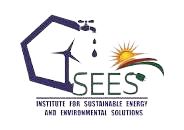 The Institute for Sustainable Energy and Environmental Solutions (ISEES) in line with its vision to see a world where all people have access to clean energy, live sustainable lifestyles and have improved livelihoods in pursuit of the Global Sustainable Development Goals have unveiled a new logo that describes its activities and operations.
The Institute for Sustainable Energy and Environmental Solutions (ISEES) in line with its vision to see a world where all people have access to clean energy, live sustainable lifestyles and have improved livelihoods in pursuit of the Global Sustainable Development Goals have unveiled a new logo that describes its activities and operations.
The Logo projects the institute’s mission and objectives.
Firstly, Sustainable Energy is one of the major focus of ISEES to reach all people with access to modern affordable and efficient energy solutions, promote renewable energy and energy efficiency in Ghana and Africa.
The wind Turbine – represents Wind Energy – which provides electrification for off-grid communities and especially energy for productive uses. ISEES main objective is to develop wind solutions for irrigation and water pumping services whiles providing alternative lighting in rural communities.
The Sun in the Logo represents energy from the Sun. ISEES seeks to identify, (research) promote (awareness creation and education) and deploy (through inclusive business models) innovative solar energy solutions to meet the needs of rural, off-grid and peri-urban households, small enterprises and communities in Ghana.
ISEES promotes and deploys solar based solutions including solar lanterns, stand alone solar home systems, off-grid and grid connected solar systems, solar heating, solar dryers (especially for increased productivity in agriculture), solar irrigation, solar charging systems and other hybrid wind, solar and biomass technologies. ISEES enhances the deployment of these solutions through the creation of sustainable markets and inclusive business to help reach off-grid rural communities with these solutions. ISEES also undertakes the development of trade relations between solar companies and grassroots associations, communities and rural entrepreneurs whiles influencing policies based on evidence based advocacy and experiences from developing sustainable markets for solar and PV systems. ISEES also conducts training and capacity building for entrepreneurs and sales outlets and provide advisory services for industry and organizations within the solar value chain.
The Electric cable in front of the S represents Energy efficiency. ISEES identifies (research) promotes (awareness creation and education) and deployment (creating sustainable markets for) energy efficient solutions in electricity, biomass and clean cooking as well as processing. Behavioral change communication is key in enhancing energy efficiency whiles promotion and deployment of energy efficient appliances and equipment provides opportunity for communities to reduce energy expenditure in the short to medium term. ISEES Technology Transfer and Deployment Department is currently promoting access to LED bulbs in households and institutions, we also promotes the deployment of efficient appliances, electrical appliances, smart meters (that informs consumers of their energy consumption) through community based awareness creation campaigns on the need to enhance energy efficiency. In addition, ISEES promotes energy efficient equipment for ago-processing that reduces fuel wood consumption, reduces the drudgery that women go through in processing oil and seeds whiles reducing energy expenditure. Technologies such as oil presses, and efficient energy equipment helps achieve this objectives in the biomass sector. ISEES also promotes efficient solutions for reducing water resource depletion and reduction in wastage of water, electricity and biomass in household and institutions.
The Red, Yellow and Green symbols under the sun represents our commitment towards environmental sustainability, biodiversity conservation, peace building, natural resources governance, and improved livelihoods. Whiles the colours depicts the Ghana flag indicating that ISEES is a Ghanaian organization, the symbol represents leafs, flowers and biomass. Effective conservation of environmental resources and the protection of eco-systems is key to enhancing livelihoods reducing the impact of climate change in communities. ISEES subscribes to the earth charter and undertakes activities to ensure conservation of earth resources. Interventions includies reduction of deforestation whiles undertaking activities towards afforestation and forest conservation, water resources conservation, eco-systems restoration, mangroves conservation, sustainable woodlots, agroforestry, natural resources governance, sustainable agriculture and oceans and wildlife conservation. Effective governance of natural resources as well as promotion of peace building is key to ensuring care for the earth, care for people and fair share our resources to sustain human lives.
The Tap with water flowing from it, depicts ISEES commitment towards the Water, Sanitation and Hygeine Sector. Access to clean water for drinking and use in households, institutions and communities is one of ISEES core objectives. In addition the protection of water resources, seeing to water conservation, purification and distribution are interventions that ISEES seeks to promote especially in rural and peri-urban areas.
ISEES also promotes sanitation and Hygiene through education, technology deployment, policy advocacy and grassroots initiatives within communities to ensure clean environments. Besides behavioral change communication, ISEES conducts research into innovative solutions for waste treatment, waste to energy conversion, water treatment, municipal, industry and household waste treatment solutions among others. Innovative technologies such as reverse osmosis, anaerobic and aerobic treatment, biogas digesters, water purification equipment, anaerobic baffled digesters (ABRs) among others are used by ISEES. ISEES seeks to research, pilot and deploy innovative solutions for improved waste treatment and sanitation for improved livelihoods and for clean environments in communities.
These concepts and methods have contributed to the development of the ISEES Logo to promote our vision, mission and objectives as well as the sectors in which form the basis of our operation in meeting the sustainable development goals in communities, governments and Africa as a whole.
